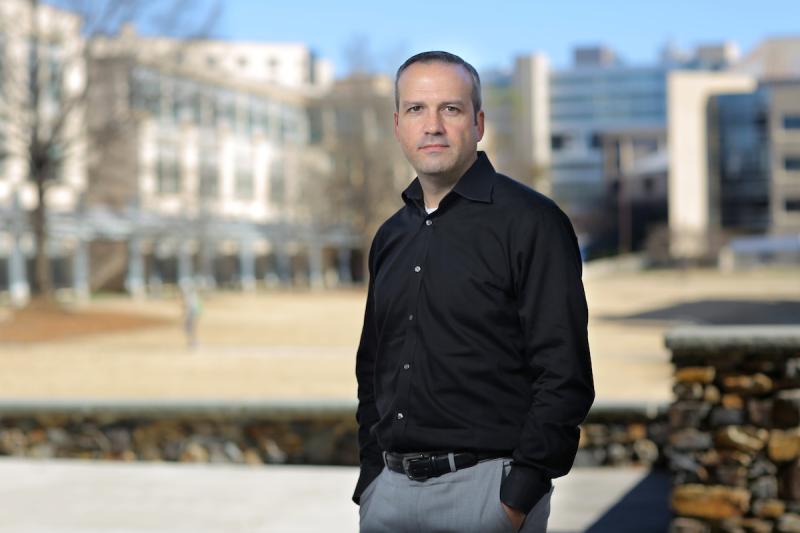
In 2016, the Duke School of Medicine selected 38 of its faculty for the new Duke Health Scholars and Duke Health Fellows Program. With funds from the Duke University Health System, the program supports the research efforts of early to mid-career clinician-scientists at Duke. Among the faculty honored are 14 individuals from the Department of Medicine, including Brent Hanks, MD, PhD, assistant professor of medicine (Medical Oncology).
These are heady days for immunotherapy researchers, the scientists making progress unleashing the human immune system against lethal cancers.
Interventions once envisioned in laboratories are now treatments saving the lives of some patients struck by melanoma, kidney cancer, and lung cancer. Promise is rising for treatments against malignancies arising elsewhere as well.
With his new insights into how cancer cells use biochemical signaling to suppress our immune system, Brent Hanks, MD, PhD, is part of this translational momentum. Specifically, he observes how malignant cells disrupt dendritic cells, which help direct attacks on cancer.
This health-threatening process depends on molecular-scale communication involving specialized receptors and biochemical pathways. Undoing such interference could help science strengthen a body’s natural defenses against cancer.
“We’re highly focused on the immune microenvironment where cancer cells are manipulating immune system cells to try to improve the immune response at a very fine scale,” said Dr. Hanks.
Basic science with a mission
Having lost his father to acute lymphocytic leukemia while a young boy in Texas, Hanks has always wanted to use science to help medicine fight malignancies.
“It’s always in the back of my mind,” Hanks said.
On an academic scholarship at Southwestern University in Georgetown, Texas, Hanks found ways to conduct research on a campus with a limited basic science infrastructure. His honors project applied his three majors — chemistry, biology and computer science — and used a supercomputer to model how changes in levels of a brain enzyme could affect tissue changes associated with Alzheimer’s disease.
“I was applying everything I had learned up to that time in that project. That was very exciting to me,” Hanks said.
At Baylor College of Medicine, Hanks worked in the laboratory of David Spencer, which had invented a technique to activate receptors on cells to modulate pathways important in drug delivery. Hanks explored how this strategy might be applied to converting dendritic cells into cancer vaccines.
Dendritic cells are vital innate immune system sentinels, constantly on the prowl for signs of danger at sites hosting inflammation, damaged tissue or might-be pathogens. When the immune sentries find suspicious cells, they carry distinctive pieces of them — antigens — to T cells to help prepare precision assaults against threats.
During his doctoral studies at Baylor, Hanks built on the laboratory’s previous work and left as a co-inventor of a now-patented technique that activates dendritic cells to better detect cancer cells. A version of the technique has been approved for phase I and phase II clinical trial testing among patients with multiple types of cancer.
A couple of years after starting his medical internship at Duke in 2006, Hanks joined the laboratory of cancer researcher Gerard Blobe, MD, PhD. As a research fellow, Hanks explored the working hypothesis that some melanomas and breast cancer cells have evolved mechanisms that allow them to change immune cells to prompt them to tolerate their presence.
Since joining the faculty in late 2012, Hanks was first to describe how cancer cells actually reprogram a vital metabolic pathway in dendritic cells. His lab found that this pathway regulates an enzyme called indoleamine 2,3-dioxygenase (IDO) that is influential in suppressing the immune response against cancer cells.
After the Hanks laboratory created a series of genetic models to define this biochemical signaling cascade, they used pharmacologic agents to reverse this pathway in pre-clinical models of melanoma. Reducing the metabolic reprogramming effect has produced an influx of tumor-infiltrating lymphocytes and improved responses to checkpoint inhibitor immunotherapy in various cancer models.
Hanks’ research focus keeps expanding. In addition to exploring the actions of tumor-generated signals that make them appear harmless, he hopes to explore pharmacological strategies to reverse that trickery, develop dendritic-cell cancer vaccines able to resist that type of interference, and identify markers of immunotherapy resistance in patients to help improve their treatment.
“Taken together, these studies offer a novel approach for identifying the biochemical pathways that play a role in clinically-relevant immunotherapy resistance. These studies will effectively function as a platform for establishing a research program in tumor-induced immune suppression,” is how Blobe describes it.
In other words, once scientists better understand the mechanisms and find ways to override them, that could expand the success of immunotherapy.
“We have a foothold and we can improve on what we’re doing,” Hanks said.
The series of profiles of our Duke Health Scholars were written by Catherine Clabby, freelance science journalist. Photos are by Ted Richardson.